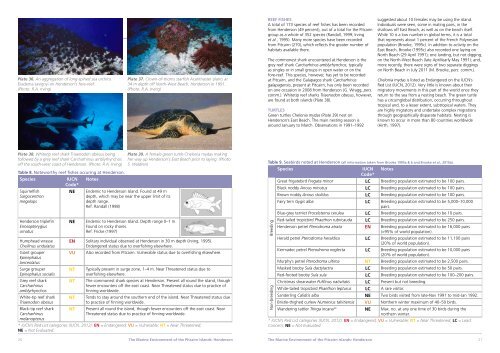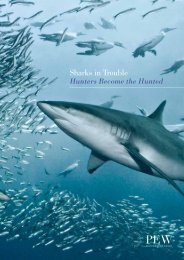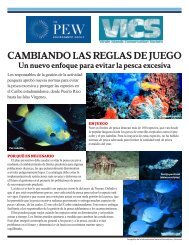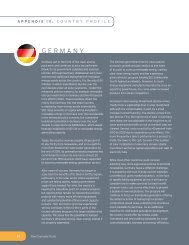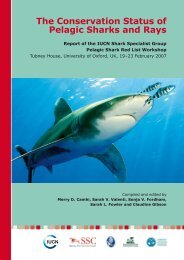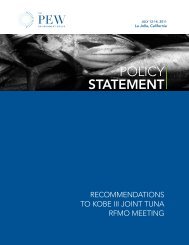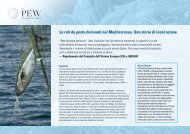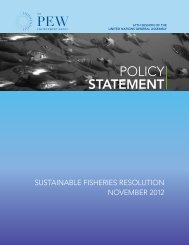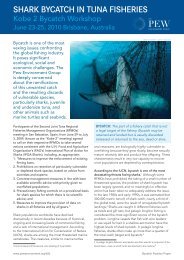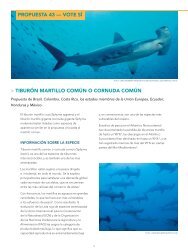The Marine Environment of the Pitcairn Islands - Pew Environment ...
The Marine Environment of the Pitcairn Islands - Pew Environment ...
The Marine Environment of the Pitcairn Islands - Pew Environment ...
Create successful ePaper yourself
Turn your PDF publications into a flip-book with our unique Google optimized e-Paper software.
Head 1<br />
body text<br />
Plate 36. An aggregation <strong>of</strong> long-spined sea urchins<br />
Diadema savignyi on Henderson’s fore-reef.<br />
(Photo: R.A. Irving)<br />
Plate 38. Whitetip reef shark Triaenodon obesus being<br />
followed by a grey reef shark Carcharhinus amblyrhynchos<br />
<strong>of</strong>f <strong>the</strong> south-west coast <strong>of</strong> Henderson. (Photo: R.A. Irving)<br />
Table 8. Noteworthy reef fishes occuring at Henderson.<br />
Species IUCN<br />
Code*<br />
Notes<br />
Squirrelfish<br />
Sargocentron<br />
megalops<br />
Henderson triplefin<br />
Enneapterygius<br />
ornatus<br />
Humphead wrasse<br />
Cheilinus undulatus<br />
Giant grouper<br />
Epinephalus<br />
lanceolatus<br />
Surge grouper<br />
Epinephalus socialis<br />
Grey reef shark<br />
Carcharhinus<br />
amblyrhynchos<br />
White-tip reef shark<br />
Triaenodon obesus<br />
Black-tip reef shark<br />
Carcharhinus<br />
melanopterus<br />
26<br />
NE Endemic to Henderson Island. Found at 49 m<br />
depth, which may be near <strong>the</strong> upper limit <strong>of</strong> its<br />
depth range.<br />
Ref. Randall (1998)<br />
NE Endemic to Henderson Island. Depth range 0–1 m.<br />
Found on rocky shores.<br />
Ref. Fricke (1997)<br />
Plate 37. Crown-<strong>of</strong>-thorns starfish Acanthaster planci at<br />
34 m depth <strong>of</strong>f North-West Beach, Henderson in 1991.<br />
(Photo: R.A. Irving)<br />
Plate 39. A female green turtle Chelonia mydas making<br />
her way up Henderson’s East Beach prior to laying. (Photo:<br />
S. Waldren)<br />
EN Solitary individual observed at Henderson in 30 m depth (Irving, 1995).<br />
Endangered status due to overfishing elsewhere.<br />
VU Also recorded from <strong>Pitcairn</strong>. Vulnerable status due to overfishing elsewhere.<br />
NT Typically present in surge zone, 1–4 m. Near Threatened status due to<br />
overfishing elsewhere.<br />
NT <strong>The</strong> commonest shark species at Henderson. Present all round <strong>the</strong> island, though<br />
fewer encounters <strong>of</strong>f <strong>the</strong> east coast. Near Threatened status due to practice <strong>of</strong><br />
finning worldwide.<br />
NT Tends to stay around <strong>the</strong> sou<strong>the</strong>rn end <strong>of</strong> <strong>the</strong> island. Near Threatened status due<br />
to practice <strong>of</strong> finning worldwide.<br />
NT Present all round <strong>the</strong> island, though fewer encounters <strong>of</strong>f <strong>the</strong> east coast. Near<br />
Threatened status due to practice <strong>of</strong> finning worldwide.<br />
* IUCN’s Red List categories (IUCN, 2012): EN = Endangered; VU = Vulnerable; NT = Near Threatened;<br />
NE = Not Evaluated.<br />
<strong>The</strong> <strong>Marine</strong> <strong>Environment</strong> <strong>of</strong> <strong>the</strong> <strong>Pitcairn</strong> <strong>Islands</strong>: Henderson<br />
REEF FISHES<br />
A total <strong>of</strong> 173 species <strong>of</strong> reef fishes has been recorded<br />
from Henderson (49 percent), out <strong>of</strong> a total for <strong>the</strong> <strong>Pitcairn</strong><br />
group as a whole <strong>of</strong> 352 species (Randall, 1999; Irving<br />
et al., 1995). Many more species have been recorded<br />
from <strong>Pitcairn</strong> (270), which reflects <strong>the</strong> greater number <strong>of</strong><br />
habitats available <strong>the</strong>re.<br />
<strong>The</strong> commonest shark encountered at Henderson is <strong>the</strong><br />
grey reef shark Carcharhinus amblyrhynchos, typically<br />
as singles or in small groups in open water or on <strong>the</strong><br />
fore-reef. This species, however, has yet to be recorded<br />
at <strong>Pitcairn</strong>, and <strong>the</strong> Galapagos shark Carcharhinus<br />
galapagensis, present at <strong>Pitcairn</strong>, has only been recorded<br />
on one occasion in 2008 from Henderson (G. Wragg, pers.<br />
comm.). Whitetip reef sharks Triaenodon obesus, however,<br />
are found at both islands (Plate 38).<br />
TURTLES<br />
Green turtles Chelonia mydas (Plate 39) nest on<br />
Henderson’s East Beach. <strong>The</strong> main nesting season is<br />
around January to March. Observations in 1991–1992<br />
Breeding<br />
Non-breeding<br />
<strong>The</strong> <strong>Marine</strong> <strong>Environment</strong> <strong>of</strong> <strong>the</strong> <strong>Pitcairn</strong> <strong>Islands</strong>: Henderson<br />
suggested about 10 females may be using <strong>the</strong> island.<br />
Individuals were seen, some in mating pairs, in <strong>the</strong><br />
shallows <strong>of</strong>f East Beach, as well as on <strong>the</strong> beach itself.<br />
While 10 is a low number in global terms, it is a total<br />
that represents about 1 percent <strong>of</strong> <strong>the</strong> French Polynesian<br />
population (Brooke, 1995c). In addition to activity on <strong>the</strong><br />
East Beach, Brooke (1995c) also recorded one laying on<br />
North Beach (29 April 1991); one landing, but not digging,<br />
on <strong>the</strong> North-West Beach (late April/early May 1991); and,<br />
more recently, <strong>the</strong>re were signs <strong>of</strong> two separate diggings<br />
on North Beach in July 2011 (M. Brooke, pers. comm.).<br />
Chelonia mydas is listed as Endangered on <strong>the</strong> IUCN’s<br />
Red List (IUCN, 2012). Very little is known about <strong>the</strong>ir<br />
migratory movements in this part <strong>of</strong> <strong>the</strong> world once <strong>the</strong>y<br />
return to <strong>the</strong> sea from a nesting beach. <strong>The</strong> green turtle<br />
has a circumglobal distribution, occurring throughout<br />
tropical and, to a lesser extent, subtropical waters. <strong>The</strong>y<br />
are highly migratory and undertake complex migrations<br />
through geographically disparate habitats. Nesting is<br />
known to occur in more than 80 countries worldwide<br />
(Hirth, 1997).<br />
Table 9. Seabirds noted at Henderson (all information taken from Brooke 1995a & b and Brooke et al., 2010a).<br />
Species IUCN<br />
Code*<br />
Notes<br />
Great frigatebird Fregata minor LC Breeding population estimated to be 100 pairs.<br />
Black noddy Anous minutus LC Breeding population estimated to be 100 pairs.<br />
Brown noddy Anous stolidus LC Breeding population estimated to be 100 pairs.<br />
Fairy tern Gygis alba LC Breeding population estimated to be 5,000–10,000<br />
pairs.<br />
Blue-grey ternlet Procelsterna cerulea LC Breeding population estimated to be 10 pairs.<br />
Red-tailed tropicbird Phaethon rubricauda LC Breeding population estimated to be 250 pairs.<br />
Henderson petrel Pterodroma atrata EN Breeding population estimated to be 16,000 pairs<br />
(>95% <strong>of</strong> world population).<br />
Herald petrel Pterodroma heraldica LC Breeding population estimated to be 11,100 pairs<br />
(20% <strong>of</strong> world population).<br />
Kermadec petrel Pterodroma neglecta LC Breeding population estimated to be 10,000 pairs<br />
(20% <strong>of</strong> world population).<br />
Murphy’s petrel Pterodroma ultima NT Breeding population estimated to be 2,500 pairs.<br />
Masked booby Sula dactylactra LC Breeding population estimated to be 50 pairs.<br />
Red-footed booby Sula sula LC Breeding population estimated to be 100–200 pairs.<br />
Christmas shearwater Puffinus nativitatis LC Present but not breeding.<br />
White-tailed tropicbird Phaethon lepturus LC A rare visitor.<br />
Sanderling Calidris alba NE Two birds visited from late-Nov 1991 to mid-Jan 1992.<br />
Bristle-thighed curlew Numenius tahitiensis VU Nor<strong>the</strong>rn winter maximum <strong>of</strong> 40–50 birds.<br />
Wandering tattler Tringa incana24 NE Max. no. at any one time <strong>of</strong> 30 birds during <strong>the</strong><br />
nor<strong>the</strong>rn winter.<br />
* IUCN’s Red List categories (IUCN, 2012): EN = Endangered; VU = Vulnerable; NT = Near Threatened; LC = Least<br />
Concern; NE = Not Evaluated.<br />
27


